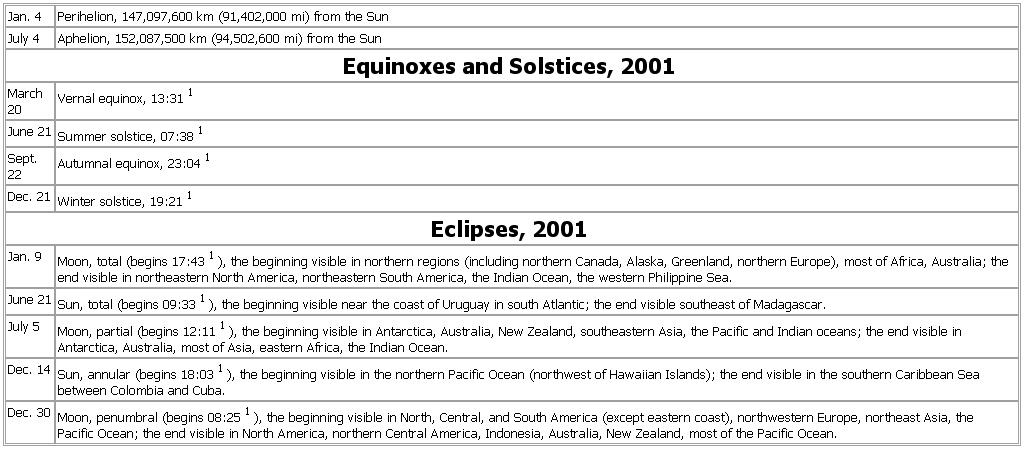Earth Perihelion and Aphelion, 2001
- Earth Perihelion and Aphelion, 2001
-
▪ 2001
Earth Perihelion and Aphelion, 2001
Jan. 4 Perihelion, 147,097,600 km (91,402,000 mi) from the Sun
July 4 Aphelion, 152,087,500 km (94,502,600 mi) from the Sun
Equinoxes and Solstices, 2001
March 20 Vernal equinox, 13:311
June 21 Summer solstice, 07:381
Sept. 22 Autumnal equinox, 23:041
Dec. 21 Winter solstice, 19:211
Eclipses, 2001
Jan.
9 Moon,
total (
begins 17:431),
the beginning visible in northern regions (
including northern Canada,
Alaska,
Greenland,
northern Europe),
most of Africa,
Australia;
the end visible in northeastern North America,
northeastern South America,
the Indian Ocean,
the western Philippine Sea.
June 21 Sun, total (begins 09:331), the beginning visible near the coast of Uruguay in south Atlantic; the end visible southeast of Madagascar.
July 5 Moon,
partial (
begins 12:111),
the beginning visible in Antarctica,
Australia,
New Zealand,
southeastern Asia,
the Pacific and Indian oceans;
the end visible in Antarctica,
Australia,
most of Asia,
eastern Africa,
the Indian Ocean.
Dec. 14 Sun, annular (begins 18:031), the beginning visible in the northern Pacific Ocean (northwest of Hawaiian Islands); the end visible in the southern Caribbean Sea between Colombia and Cuba.
Dec.
30 Moon,
penumbral (
begins 08:251),
the beginning visible in North,
Central,
and South America (
except eastern coast),
northwestern Europe,
northeast Asia,
the Pacific Ocean;
the end visible in North America,
northern Central America,
Indonesia,
Australia,
New Zealand,
most of the Pacific Ocean.
See as table:
1Universal time.
Source: The Astronomical Almanac for the Year 2001 (2000).
* * *
Universalium.
2010.
Look at other dictionaries:
Earth Perihelion and Aphelion, 2002 — ▪ Table Earth Perihelion and Aphelion, 2002 Jan. 2 Perihelion, 147,098,130 km (91,402,370 mi) from the Sun July 6 Aphelion, 152,094,370 km (94,506,880 mi) from the Sun Equinoxes and Solstices, 2002 March 20 Vernal equinox, 19:161 June 21 Summer … Universalium
Mathematics and Physical Sciences — ▪ 2003 Introduction Mathematics Mathematics in 2002 was marked by two discoveries in number theory. The first may have practical implications; the second satisfied a 150 year old curiosity. Computer scientist Manindra Agrawal of the… … Universalium
Earth — This article is about the planet. For other uses, see Earth (disambiguation). Earth … Wikipedia
Near-Earth object — Asteroid 4179 Toutatis is a potentially hazardous object that has passed within 2.3 lunar distances … Wikipedia
Physical Sciences — ▪ 2009 Introduction Scientists discovered a new family of superconducting materials and obtained unique images of individual hydrogen atoms and of a multiple exoplanet system. Europe completed the Large Hadron Collider, and China and India took… … Universalium
Near-Earth asteroid — Near Earth asteroids (NEAs) are asteroids whose orbits are close to Earth s orbit. All near Earth asteroids spend part of their orbits between 0.983 and 1.3 astronomical units away from the Sun. Some near Earth asteroids orbits intersect Earth s… … Wikipedia
166P/NEAT 2001 T4 — Infobox Comet name=166P/NEAT discoverer=NEAT discovery date=October 15, 2001 designations=2001 T4 epoch=March 6, 2006 semimajor=13.83 AU perihelion=8.559 AU aphelion=19.1 AU eccentricity=0.3811 period=51.43 a inclination= 15.3813° last p=May 15,… … Wikipedia
Milankovitch cycles — Past and future Milankovitch cycles. VSOP allows prediction of past and future orbital parameters with great accuracy. ε is obliquity (axial tilt). e is eccentricity. ϖ is longitude of perihelion. esin(ϖ) is the precession index, which together… … Wikipedia
Sun — This article is about the star. For other uses, see Sun (disambiguation). The Sun … Wikipedia
Solstice — For other uses, see Solstice (disambiguation). UTC date and time of solstices and equinoxes[1] year Equinox Mar Solstice June Equinox Sept Solstice Dec day time day time day time day time 2004 20 … Wikipedia
 1Universal time.Source: The Astronomical Almanac for the Year 2001 (2000).
1Universal time.Source: The Astronomical Almanac for the Year 2001 (2000).